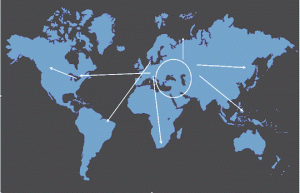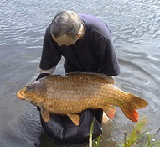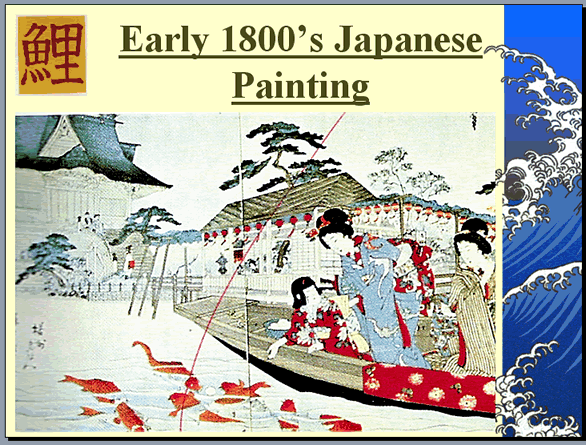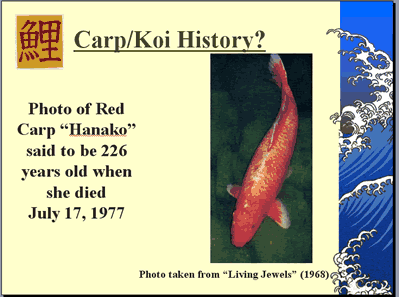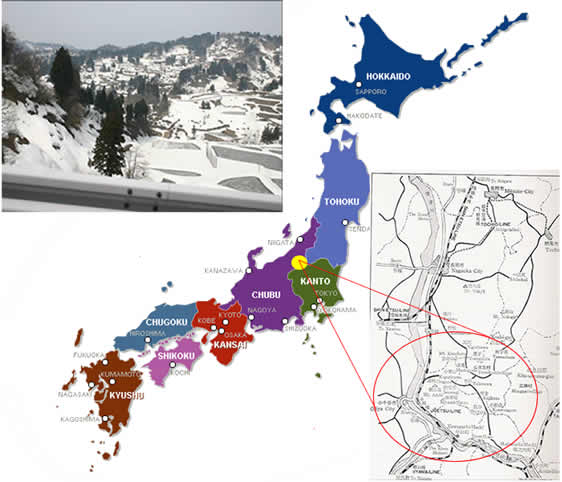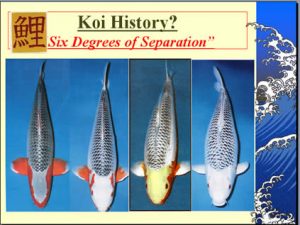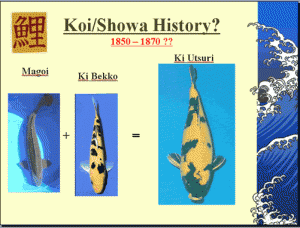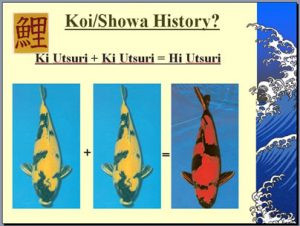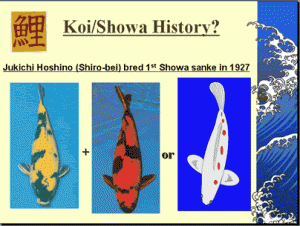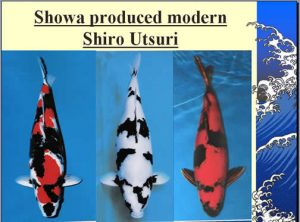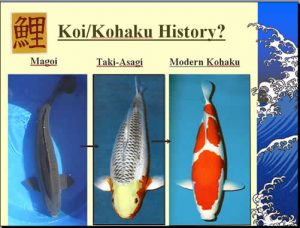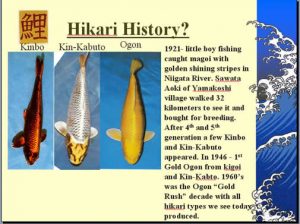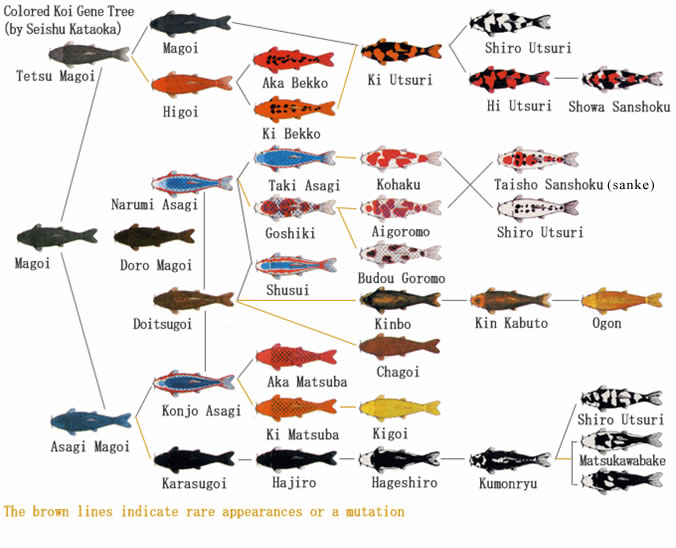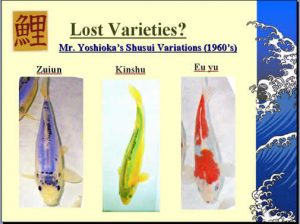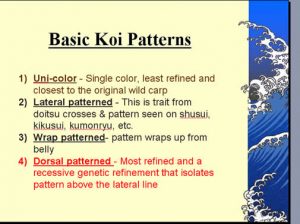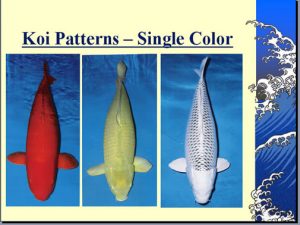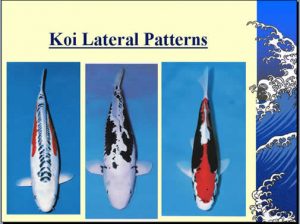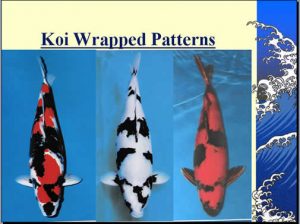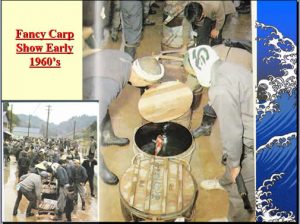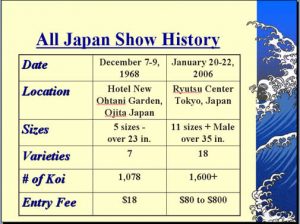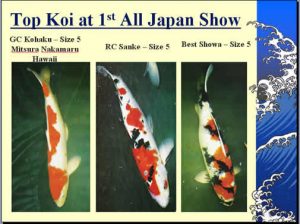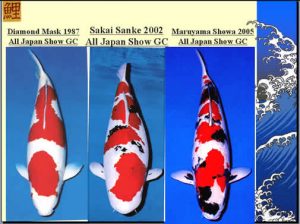Author Archives: Bruce Gresham
Koi History by Ray Jordan
 No written history was kept of the early development of colored carp. Oral history of colored carp/koi is sketchy and often there are many different variations on how specific varieties of koi were developed. That said, here is the version that rings most true to my ear.
No written history was kept of the early development of colored carp. Oral history of colored carp/koi is sketchy and often there are many different variations on how specific varieties of koi were developed. That said, here is the version that rings most true to my ear.
Origin/Distribution of Cyprinus carpio
It is believed that the common river carp originated in the Caspian & Black sea area. Carp were traded and carried father and farther from their original location because of their ability to survive in many different types of climates and waterways.
Common river carp have been raised for food for thousands of years.
Carp sometimes have natural mutations of colors including spots or bellies that are red, brown, grey, light blue/grey, light yellow, and tortoiseshell. Carp farmers all over the world would have seen these same mutations but only in the Niigata area of Japan were carp developed and refined successfully by selective breeding to eventually become what we know today as living jewels (koi).
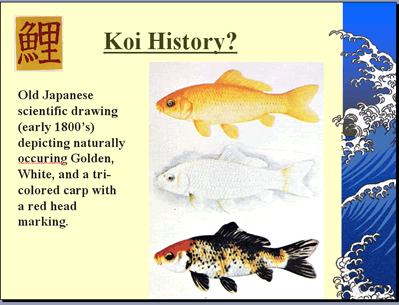
Carp in Eastern Cultures
- Carp is an Auspicious Animal believed to possess special attributes – Strength, Health, Persistence, Luck, Wealth, & Destiny
- There is an important myth of a carp leaping up a waterfall and swimming tirelessly upstream to reach the headwater. When it succeeded, it was rewarded by transformation into a mighty dragon. In China, images or statues of carp are a traditional gift to a student beginning school.
- In Japan, auspicious colors are red, white, black, blue, yellow, & brown.
- The color Red (aka) is an expression of happy or bright feelings. Red evokes images of fortunate or happy occasions, symbolized by red and white as seen on kohaku.
- “Nishikigoi begins and ends with Kohaku.”
- Japanese prefer the majority of koi in a pond should be Kohaku to convey bright, happy feelings.
Carp sometimes have natural mutations of colors including spots or bellies that are red, brown, grey, light blue/grey, light yellow, and tortoiseshell. Carp farmers all over the world would have seen these same mutations but only in the Niigata area of Japan were carp developed and refined successfully by selective breeding to eventually become what we know today as living jewels (koi).
Why Were Koi Created Only in Niigata, Japan?
- Very isolated in winter
- 20+ feet of snow accumulation
- Lack of fresh food in winter
- Very Artistic/Creative/Competitive People
- Profit – Colored Carp were valuable
- Competitions (Annual Formal Koi Shows in Niigata area since 1912)
- Artistic – Create something new, exciting, & unique.
It is believed carp first came to Japan by way of China about 400 – 600 years ago. Likely the remoteness of the mountainous Niigata area and especially in their harsh winters, with up to 20 ft of accumulated snow, inspired these home-bound villagers to find something beautiful to occupy their minds. Winters were so harsh that some carp had to be brought into temporary ponds inside their small homes to survive.
It is incredible to think that some bored rice/carp farmer, gazing at some of his pet magoi with a few red or gold spots, started thinking “I can breed Spot and Speckles and create a new type of colorful carp and then sell them for lots of Yen.”
Imagine what he would think if he could return today and see how popular, beautiful and expensive some of the descendants of his pet fish experiment had become.
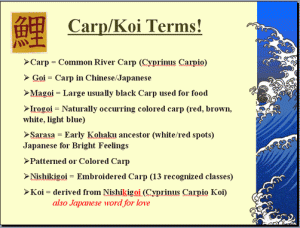
Carp in Niigata: Breeding for Color Begins
- Key Dates in Koi History
- 1889 – Kunizo Hiroi (Gosuke) bred 1st modern kohaku
- 1904 – 1st German carp imported and bred to asagi
- 1908 – Post Russo/Japan War boom – colored carp prices soar – sales banned – 1st koi shows
- 1914 – Patterned Carp Exhibition in Tokyo
- 1917 – Elizaburo Hoshino, bred 1st Taisho sanke
- 1927 – Jukichi Hoshino (Shiro-bei) bred 1st Showa sanke
- WW II – Most koi lost – confiscated for food
- 1946 – Sawata Aoki created first Yamabuki Ogon
- 1950 – Hiroshima area produced 1st gin rin Kohaku
- 1960 – First plastic bags & use of oxygen
- 1964 – Tomiji Kobayashi developed new style showa
- 1968 – ZNA formed – 1st ZNA – All Japan Show
- 1980 – AKCA formed
Some of the earliest accidental occurring types of colored carp seen were Magoi (large black wild carp) with red bellies. From these early colored carp came three types of “different magoi.” Finally three separate branches of koi genealogy emerged.
It is believed that Magoi & Hi-goi and crosses produced “black based” koi. First came Hi (red) and Ki (yellow) bekkos with black tortoise shell markings.
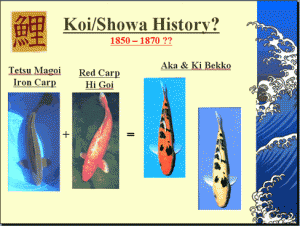
From darker Asagis came Goshiki, then later Koromo, Aka and Ki Matsubas, Karasu (all black), Hageshiro (black with white fins), and Matsukawa-bake (black with changeable white pattern).
From lighter blue based asagis came the white based koi. Taki-asagi (White sided) were the type of asagi used to eventually produce the first Kohaku. About 1830, Taki-asagi pairings produced a few white carp with red spots. These were the first colored carp to be called Kohaku (Red & White) and were the early ancestors of the modern Kohaku which is still the most popular koi kept today.
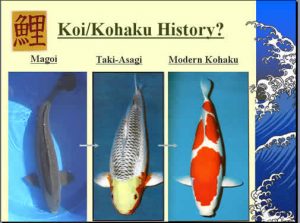 In the late 1800’s there were a few unique red & white fish produced from breeding Taki Asagis. . In 1889 Kunizo Hiroi (Gosuke) bred a female carp that was white with a red head to a male carp with a red cherry blossom pattern to produce the first modernkohaku.
In the late 1800’s there were a few unique red & white fish produced from breeding Taki Asagis. . In 1889 Kunizo Hiroi (Gosuke) bred a female carp that was white with a red head to a male carp with a red cherry blossom pattern to produce the first modernkohaku.
Kohakus were bred with Goshiki – Asagi and/or Hi Bekkos to produce the first “old style” Sankes and also shiro bekkos. In the post Russo/Japan war boom years the koi market exploded and prices soared to the point that the sale of koi was banned for awhile. But like our own Prohibition, the koi black market thrived. After a few years the sale of koi was permitted – and taxed – again.
Imagine after the fall harvest groups of rustic Niigata carp/koi farmers celebrating in Ojita City with pockets bulging with yen made by selling their “colored” carp.
Must have been quite a celebration.
Carp in Niigata: Breeding for Color Continues
Glossary:
aka, beni, hi = different shades of red
sumi = black
shiro = white
ki – yellow
motoguro= black spots at the base of pectoral fins

In 1917 a Niigata koi farmer, Elizaburo Hoshino, bred a special male kohaku with a female Ai Goromo which had just a few spots of sumi netting. This produced the 1st Taisho sanke sanshoku (modern type).
About the same time, Ki bekkos were bred with magoi to produce the first Ki Utsuri.
Finally Hi and/or Ki Utsuri and Kohaku or White-ish Kawarigoi with red spots were bred by Jukichi Hoshino (Shiro-bei). He produced the first “original style” Showa that looked somewhat like Hi/Ki utsuri in the early 20th century. These early showas had goshiki-like (grayish) shiro and striped fins.
The next change was accomplished by breeding showa to asagi, which helped produce motoguro marked fins. In 1964 Tomiji Kobayashi crossed a Male Yogozen Kohaku with a female showa to produce a new style showa with a large dorsal crimson red pattern. It also had a brighter white ground without netting, deep wrapping sumi that formed motoguro, and a zigzag pattern on the head.
Jukichi Hoshino (Shiro-bei) produced the first “original style” Showa that looked somewhat like Hi/Ki utsuri in the early 20th century. These early showas had goshiki like (grayish) shiro and striped fins. Next change was accomplished by breeding to asagi which helped produce motoguro marked fins.
In 1964 Tomiji Kobayashi crossed a Male Yogozen Kohaku with a female showa to produce a new style showa with a large dorsal crimson red pattern. It also had a brighter white ground without netting, deep wrapping sumi that forms motoguro, and a zigzag pattern on head.
There were three additional major steps in the development of the modern koi we see today.
1. Doitsu
First, German carp, which were scale-less and tan colored, were introduced into Japan in 1904. Some early crosses with Asagi produced Shusui, Chagoi, and Kumonryu. These fish, which have very few or no scales, are called “doitsu” – the Japanese pronunciation of “Deutch”.
Most types of koi bred today have had a doitsu version produced. Some popular varieties such as kujaku were actually first produced in the doitsu form and later crossed with scaled koi to develop into the form and pattern we know today.
2. Metallic
Second, in 1921, Sawata Aoki heard the story of a special carp with streaks of gold on its dorsal fin, which had been caught in the river near Hirose village about 30 kilometers away. Sawata felt compelled to walk to the area and see this carp. It was a black magoi with a shine at the base of its dorsal fin. He bought it for a high price and took it home.
After he allowed it to grow large he bred it, keeping only the very few babies that had any golden shine. Over the next 25 years he produced koi there were more and more metallic – Kin Kabuto, Gin Kabuto, Kinbo and Sakin.
In 1946 Sawata spent a small fortune, 60 yen, to buy a famous female koi of the shiro-fuji (White with shiny silvery head) type which he crossed with his own most improved metallic offspring. This was at the end of World War II and times were very hard. There was no money to buy food for the koi fry so he would catch insects all day and chew them into tiny bits to feed his fry. The people of his village believed he was crazy.
By the end of the summer there were two koi out of this group that had a shining gold sheen all over their bodies. They were also twice the size of their brothers and sisters. These were the original ogon koi (metallic golden scaled dark koi). Can there be any doubt that the special care and devotion shown by Sawata to his creations has produced generations of ogon koi that seem to be more easily tamed than any other type of koi?
Sadly, Sawata never benefited from his creation. He spent everything he had, and he and his family lived in rags, to produce a few first ogons. Later other breeders like Takehira Hoshide would acquire his ogon offspring and develop more refined brightly colored Yambukis (gold) and Platinums (silver). The first of these 2nd generation ogons sold for huge sums of money. Ogons are the basis for creating all the metallic types of koi we see today, including Kin Showa, Kujaku, Hariwake, Yamato Nishiki, and Kikiuryus.
3. Ginrin
Third, in Hiroshima (Southern Japan) about 1920 some magoi were discovered that had scales along their backs that sparkled like diamonds. These diamond type scales were first called “Dia Ginrin”.
Many attempts were made to breed these magoi to get baby koi with these types of scales all over the body. Then these Dia Ginrin koi were bred to popular types of koi.
About 1950 the first kinginrin kohaku appeared. Some of these first Dia Kohakus sold for $30,000 in the 1950’s. Dia Ginrin is more commonly called Hiroshima ginrin today.
Several other types of gin rin have been developed including Tama also called pearl gin, beta gin, and kado, also called “edge”, gin.
It is amazing to think that in a little over 100 years all the 100+ named varieties we know today were developed. Most since World War II when almost all koi were lost in Japan due to lack of food and orders from the military to forfeit all carp to be eaten. Fortunately the core koi brood stock was hidden in secluded Shinto temple ponds. After the war the survivors were recovered and breeding began again. But that is another story entirely.
- Carp/Koi History Terms
- Carp – Common River Carp (Cyprinus carpio)
- Goi – Japanese for Carp
- Magoi – Japanese for black carp grown for food
| Variety | First bred about | Breeder | Parent Koi | Parent Koi |
|---|---|---|---|---|
| Asagi | Early 1800's | Spontaneous generation | Lighter colored Asagi Magoi | |
| Ki Bekko | Mid 1800's | Spontaneous generation | Magoi | Hi-goi |
| Kohaku | 1889 | Kunizo Hiroi (Gosuke) | White female(red head) | White male (red-cherry blossom pattern) |
| Original Sanke | 1890-1900 | ? | Kohaku | Shiro Bekko |
| Shusui | 1910 | Kichigoro Akiyama | Asagi sanke | Doitsu mirror carp |
| Ki Utsuri | 1921 | Elzaburo Hoshino | Ki Bekko | Magoi |
| Ki Utsuri (refined) | 1924 | Mosaku Hiroi | Ki Utsuri | Ki Utsuri |
| Shiro Utsuri | 1925 | Kazui Minemura | Magoi | |
| Showa | 1926 or 1927 | Jukichi Hoshino (Jintaro) | (M) Ki or Hi Utsuri | (F) Kohaku or red/white Kawarigoi |
| Dark Ogon | 1946 | Sawata Aoki | Kinbo | Kin Kabuto |
| Yamabuki Ogon | 1957 | Sawata Aoki | Ki-goi | Light colored Ogon |
| Doitsu Kujaku | 1960 | Toshio Hirasawa | Hariwaki | Shusui |
| Platinum Ogon | 1963 | Tadao Yoshioko | Ki-goi | Nezu Ogon |
| Midori-goi | 1963 | Tacho Yodhioka | Male Yamabuki Ogon | Female Shusui |
| Kobaysahi Showa | 1964 | Tomiji Kobayashi | (M) Yagozen Kohaku | (F) Showa |
| Yamato-Nishiki | 1965 | Seikichi Hoshino | Sanke | Ogon |
| Beni Kumanryu | 1980 | Megumi Yoshida | Male Kumanryu | Female Doitsu Kohaku |
| Kikikuryu | 1993 | Kataoka & Aoki | Kumanryu | Doitsu Kikusui |
| Beni Kikikuryu | 1995 | Kataoka & Aoki | Beni Kumanryu | Doitsu Kikusui |
Koi Pattern Development
Champions, Then…
…and Now
Copyright 2006 Ray Jordan
<end>


